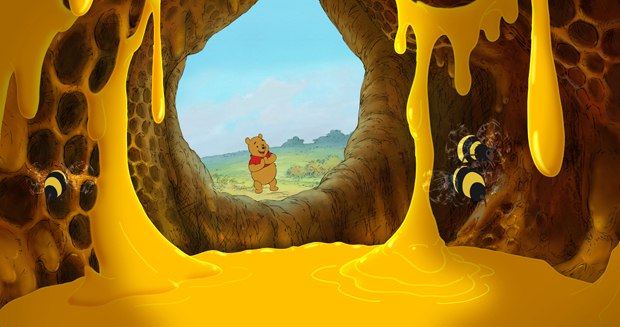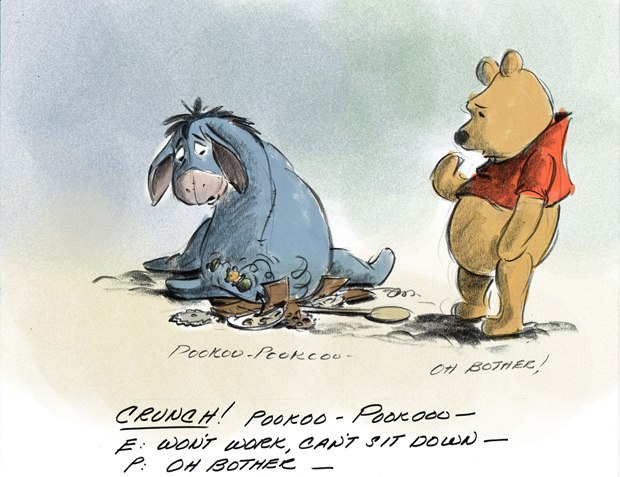Disney turns to Pooh for its latest hand-drawn feature.
Check out the Winnie the Pooh trailers and clips at AWNtv!
It turns out that there was less pressure on Winnie the Pooh (opening today) than The Princess and the Frog to make or break the hand-drawn tradition at Disney. That's because it's a proven brand and doesn't carry the same kind of baggage. Still, even though it wasn't as artistically daunting as Princess (a tag-team approach because of a tight 10-month production schedule), there was the challenge of reinvigorating a franchise that had been watered down for cable and DVD.
But John Lasseter and Ed Catmull had enough faith in its potential and universal appeal to greenlight a feature based on the popular A.A. Milne property (adapting three stories fthat had never been animated before). So they turned to producer Peter Del Vecho (Princess), directors Stephen Anderson (Meet the Robinsons) and Don Hall (head of story for Princess), as well as Disney's 2D dream team, which consisted of Dale Baer (Owl), Andreas Deja (Tigger), Eric Goldberg (Rabbit), Richard Haycock (Eeyore), Mark Henn (Pooh and Christopher Robin), Bruce Smith (Piglet, Kanga and Roo) and senior story artist Burny Mattinson.
They not only went back to the roots of Pooh to rediscover its wit and simplicity, but they also went to Milne country in England to soak up the places that inspired the author, especially Ashdown Forest in East Sussex, where they sketched, painted and soaked up the architecture and soft English light.
The result is a Winnie the Pooh that channels the past yet bears an unmistakably contemporary stamp, with more slapstick and artistic plussing that comes from the latest and greatest digital enhancements. The honey, for instance, may look like CG, but it's actually hand-drawn with some creative Photoshop filtering.
"This is obviously a simpler film, Hall says. "We just had to get everybody's head wrapped around, mostly in effects, not doing tone maps, casting shadows very sparingly. At first, they were like, 'Well, what are we gonna do on this movie?' I told them to trust us. You're going to have plenty to do -- the honey sequence and the Backson sequence. So it was really more about training people not to bring all their tools to this."
"They were actually going to try to make it look exactly like the original," Baer adds. "Make it look like film, Xeroxed, paint shatter, cell shadows, which would've been neat. But with the technology today we've been able to enhance everything that we couldn't back in the '70s."
Lasseter told them that this was their generation's Pooh, and not be afraid to be more expressive.
"With Rabbit, I went into commando mode," suggests Goldberg, who also supervised the "Backson" fantasy sequence. "I pushed his frustration, using Faulty Towers as an inspiration, but he winds up where he needs to be."
Mattinson says early on they realized that the gang from the Hundred-Acre Wood was looney like Cuckoo's Nest, and that loosened up their creative spirit. "Let's have more fun with them," he suggests.
Of all the characters, though, Owl gets more attention. "At first, I went by the old model sheets to make it look just like the traditional Owl that everyone is used to seeing," Baer recalls. "But for some reason, when I looked at the test with Craig Ferguson's dialogue, I realized that he added a lot more. Same kind of personality and ego, but bigger than before."
However, there was still the fundamental story challenge of seamlessly incorporating three episodes involving Eeyore losing his tail, Pooh in search of honey and the spooky Backson bogey man.
"What's great about Winnie the Pooh is that these characters are so innocent that they can go off on tangents," says Hall. "If they have a particular goal that day, they'll leave the house and pursue it, but then something else is going to happen, and before you know it, something else happens and they've gone on circuitous paths. So we wanted to make sure that it was organically unfolding. We weren't imposing a story structure on the characters, but at the same time, it couldn't seem random. The challenge in story development was: 'How much do we structure this like a traditional movie, and how much do we pull back and let the characters inform the course of the film?'"
And considering how self-reflexive the narrative is, with the interplay between narrator and characters and sentences flying off the page at will like another character, it's clear that Winnie the Pooh is not just for kids.
"We heard stories that at a USC test screening they were standing in line for five hours and turned people away," insists Anderson. "But getting a free screening and getting them to pay money is a whole other thing. But it certainly gives us confidence that we achieved what we wanted to do, which was to create a broad audience movie."
Bill Desowitz is former senior editor of AWN and editor of VFXWorld. He has a new blog, Immersed in Movies (www.billdesowitz.com), and is currently writing a book about the evolution of James Bond from Connery to Craig, scheduled for publication next year, which is the 50th anniversary of the franchise.










